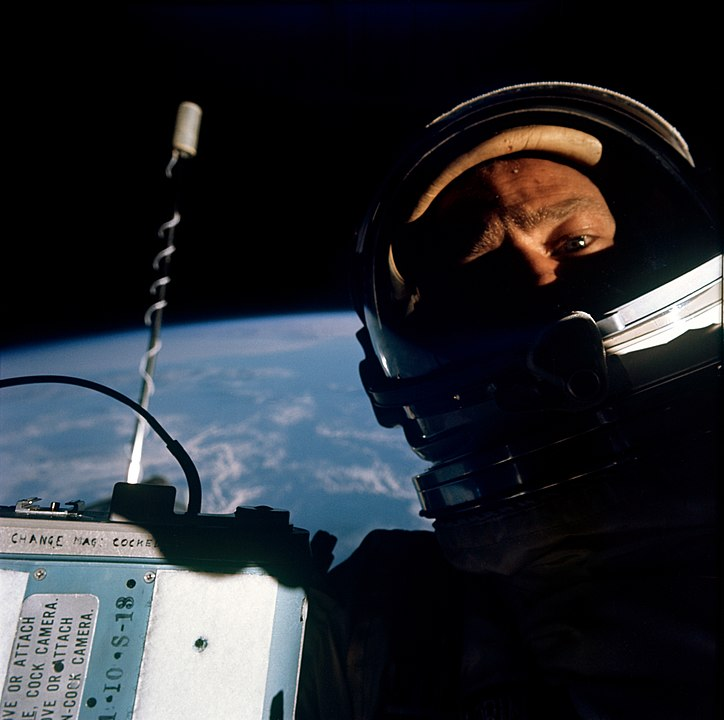From Close-Up to Selfie
Today, psychology of the close-up. The University of Houston presents this series about the machines that make our civilization run, and the people whose ingenuity created them.
Are you ready for your close-up?
The classic noir film, Sunset Boulevard, ends with a close-up, when an aging former star dreams about the past by announcing "Mr. DeMille, I'm ready for my close-up." In her imagination, the former star welcomes the close-up because it could launch her to stardom. For Sunset Boulevard's audience, however, the scene's "up close" glimpse of faded cheeks and lined face are poignant reminders of the sadness of her dream.

Sunset Boulevard - 'Ready for my close-up'
Photo Credit: Wikimedia Commons.
The close-up's technique and emotional impact are now so intrinsic to movies that it is hard to imagine the shock it presented in cinema's earliest days. In 1911, pioneering filmmaker D.W. Griffith had to argue with his film crew, who were used to shooting whole bodies, by yelling in their faces and pointing out that it was now impossible to see feet. By insisting on bringing the camera so close to actors, Griffith's close-ups taught viewers and filmmakers how exaggerated attention to faces gives huge emotional and narrative power.

Buzz Aldrin during Gemini 12 EVA
Photo Credit: Wikimedia Commons.
Film scholars disagree about who and when was first to use the close-up, but within a few years it was already a recognized film convention. In a 1916 book about the "photoplay" - - a term from so early in film's history that the word "movie" wasn't yet widely used - - Harvard psychologist Hugo Münsterberg praises close-ups for "enlarg[ing] a detail" to the point that "everything else disappears." For Münsterberg, close-ups' visual proximity are how film arouses "attention, memory, imagination, and emotion."
The close-up, in other words, sparks empathy--as evident in that unforgettable scene from Sunset Boulevard. But while today's movies still have close-ups, most of our modern screen interactions are not celluloid but digital. In terms of the close-up, this means that nowadays our most common experience of an up-close facial portrait shot by a camera is no longer movies' empathic, third-person gaze, but rather the self-indulgent self-absorption of the selfie.
What's at stake in this twenty-first-century eclipse of the close-up by the rise of the selfie? The close-up made movie stars, but selfies are how we star in the movies of our lives. This explains the selfie's appeal for its makers - - but in an age when everyone vies for the attention once commanded by film stars, how do we even know now where to look?

Macaca nigra self-portrait
Photo Credit: Wikimedia Commons.
Let me be clear that I'm not worried about movie stars (who are, after all, still very privileged!). Rather, I'm interested in the psychological differences between close-up and selfie, and how close-ups offer social and psychological benefits that selfies do not.
Research shows that social media posts of clinically depressed are heavily self-centered and, by contrast, that sharing imagery, thoughts, or accomplishments of others has mental health benefits. Think about the morale boost gained by a whole community, when one remarkable high school art student sketched individual portraits of every single one of his peers before graduation.
Today we all have in our purses and pockets a device that lets us to be a DeMille or a D.W. Griffith, and to photograph and share other people's stories in the way that movies used to bring glamor and compassion to stars.
So let's shut down selfie mode and turn our cameras back on the wonderful people around us.
I'm ready to take your close up!
I'm Karen Fang, for the University of Houston, where we're interested in the way inventive minds work.
Hugo Münsterberg, The Photoplay: A Psychological Study. New York: Appleton, 1916, pp.172-173. See also Up Close with the Close-Up.
How social networks like Instagram could help identify when someone is depressed (Business Insider); How your social media betrays your mood (BBC); Share the love with positive posts (Lea Waters, Gerry Higgins Chair in Positive Psychology, University of Melbourne).
For graduation, student draws his entire senior class-all 411 of them - Click here.
"Mr. DeMille, I'm ready for my close-up" (Sunset Boulevard final scene): Click here.
This episode was first aired on March 10, 2020